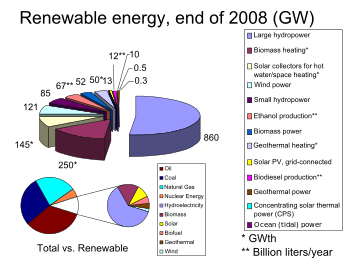Today we review a “future history” that begins by assuming that by 2030 the world will not only have accepted but embraced
carbon pricing. The authors predict what changes would be needed to get there with emphasis on what the two biggest CO2 emitting nations, the USA and
China, do and why they do it (different reasons). Key aspects are the socio-economic benefits that accrue after carbon taxes are implemented, the penalties that arise (such as legal liabilities for climate impacts) when the main players are slow to respond and the role played by the
British Columbian government in Canada in enacting a province-wide
carbon tax on consumers which was both successful and popularly supported and served as a model for other jurisdictions
.

English: U.S. Energy Flow Chart of 2008 Estimated U.S. Energy Use in 2008 is ~99.2 quads (Photo credit: Wikipedia)
Key Quotes:
“It’s 2030 and instead of racing toward the brink
of climate catastrophe the world has begun to back away. …although
carbon dioxide (CO2) concentrations in the atmosphere breached 450
parts
per million (ppm) last year—the level believed to offer a 50 percent
chance of holding global warming below 2 degrees Centigrade this
century—the rate of increase has slowed dramatically.”
“countries
need not wait on internationally coordinated efforts if some carbon
mitigation is in their own national interests—that is, the domestic
environmental benefits exceed the CO2 mitigation costs, leaving aside
climate benefits.”
Benefits of carbon pricing:
• “Fiscal
advantages. Revenue from pricing carbon, whether generated from a tax or
from the auction of tradable permits, has made it possible to roll back
and even eliminate other, more distorting taxes….
• A
wealth-creating green industrial revolution . [7] Countries that moved
early to price emissions experienced a surge of investment into
climate-friendly technologies: hyper energy efficiency, cheap clean
renewables, energy-saving nanotechnologies, and green biotech. …
• Better health, reduced pollution. Reductions in noncarbon local and regional pollution, especially from coal (
ultrafine particle
pollution known as PM2.5, sulfur dioxide, carbon monoxide, mercury,
lead, zinc, cadmium, and soot) but also from oil and natural gas, have
cut cancers and cardiovascular and respiratory diseases around the
world…”
“The company [
Exxon Mobil] also suffered a major blow in
the early 2020s when it lost a multi-trillion-dollar class action suit
brought by an alliance of US state attorneys general, displaced
residents of submerged island states, and environmental groups seeking
damages in connection with the firm’s support for climate denial junk
science.”
“US interest in carbon pollution taxes was also boosted
by slowly growing awareness of the success of a carbon tax implemented
in the western Canadian
province of British Columbia
starting in 2008. A 2013 assessment of the tax … found that the
province’s consumption of fossil fuels covered by the tax fell 19
percent per capita compared with the rest of the country, while the
province’s economy outperformed most of Canada…polls in British Columbia
showed that public support for the provincial carbon tax increased
during the first four years of implementation, to 64 percent.”
“In
2015 China imposed a 10 yuan per ton tax on carbon emissions, with the
proceeds split evenly between the central government and the provinces.
Collections were made upstream, at the extraction points for coal and
oil (mine mouths and wellheads) and at the port of entry for imports of
coal, oil, and natural gas….Today China has carbon taxes of 50 yuan per
ton”
Responses to higher energy prices:
• “ were changes in
household and firm behavior, activities such as insulating homes and
commercial and industrial structures, switching to lower-energy lighting
fixtures, taking fewer and shorter car trips, and making greater use of
public transport.”
• increased investment in new technology for energy production, distribution, and use…”
• the surge of investment into
carbon capture and storage (CCS) technologies for retrofitting existing coal- and oil-burning power plants.”




















































